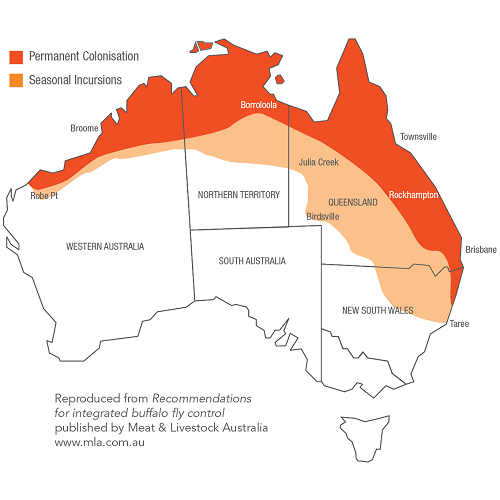LIVESTOCK: OFFERS FROM THE AUTUMN CATALOGUE
Here are our leading offers for Livestock from the Autumn Catalogue. Bonus items will be available in-store at your local AIRR member…
Nationwide shipping! Now with Express shipping option as well. Click here for details.
Courtesy Elanco

The buffalo fly (Haematobia irritans exigua) is a major pest and cattle welfare issue in northern Australia. Like the cattle tick, the buffalo fly was accidentally introduced into northern Australia from Asia in the 19th century. Since then, this pest has spread across much of the tropical north and as far south as central New South Wales. The prevalence of buffalo fly has fluctuated further south over recent years, with one of the most likely reasons for this being climate change.

Buffalo flies can only survive 1 or 2 days off their cattle or buffalo host, with females leaving briefly to lay their eggs in fresh dung pats before returning to a host. The life cycle is temperature dependent with warm, wet weather conditions between 25°C and 35°C favouring egg development. Under ideal conditions, a life cycle can be completed in just 10 – 20 days allowing populations to build up rapidly over a season. Buffalo fly can readily spread between cattle, across properties and from introduced cattle.
The buffalo fly is a small external, blood-sucking parasite, up to 4mm in length that feeds off cattle and buffalo. Buffalo flies bite their host up to 40 times per day, mainly attacking the withers, shoulders, flanks and around the eyes, and causing severe irritation and production setbacks when infestations are high. Cattle rub on infrastructure to find relief, which not only results in damage but causes lesions on the hide of cattle. This reduces hide value and may also restrict access to live export. Flies can also spread diseases such as the bacteria causing pinkeye (Moraxella bovis) and the Stephanofilaria sp. worm, which causes severe skin sores around the eyes and body of affected cattle. Such sores can become infected and attract other flies. The distress that buffalo flies cause can disrupt grazing time and reduce overall feed intake, resulting in productivity setbacks.
Buffalo flies are now considered the most costliest endemic disease for the Australian cattle industry, costing $170.3 million annually in prevention and production costs, according to a 2022 Report on Endemic Diseases for the Red Meat Industry.1

Cattle of any age can be affected by buffalo flies. However not all cattle will experience the same level of fly infestation, with cattle with dark coats, bulls and those in poor condition likely to carry larger fly burdens. Bulls tend to show more signs of stress from the presence of flies. Some cattle can also be ‘allergic’ or more sensitive to flies and are intensely irritated by as few as 4 or 5 flies.
An integrated approach to control buffalo fly should be used to reduce fly numbers to an acceptable level, so that production losses are minimised and cattle welfare isn’t compromised. Non-chemical control methods, such as fly trap tunnels and dung beetles can be used to lower fly burdens and reduce reliance on insecticide use. Culling sensitive cattle and selectively breeding cattle genetically predisposed to carrying fewer flies are also strategies that can be adopted. However, using chemical controls and treatments currently remain the most effective way to manage buffalo flies, particularly when fly pressure is high. Methods include insecticide ear tags (e.g. Patriot™, Co-Ral™ Plus, Cylence™ Ultra), sprays and pour-on’s (e.g. Baymec™ Pour-On, Acatak™ Duostar).
Buffalo fly resistance is well-documented so it is important that treatments are used strategically to ensure they remain effective, including:
Great range - quick and secure delivery
Buy securely online and pickup at your local store
Call your local store and come on down to pickup